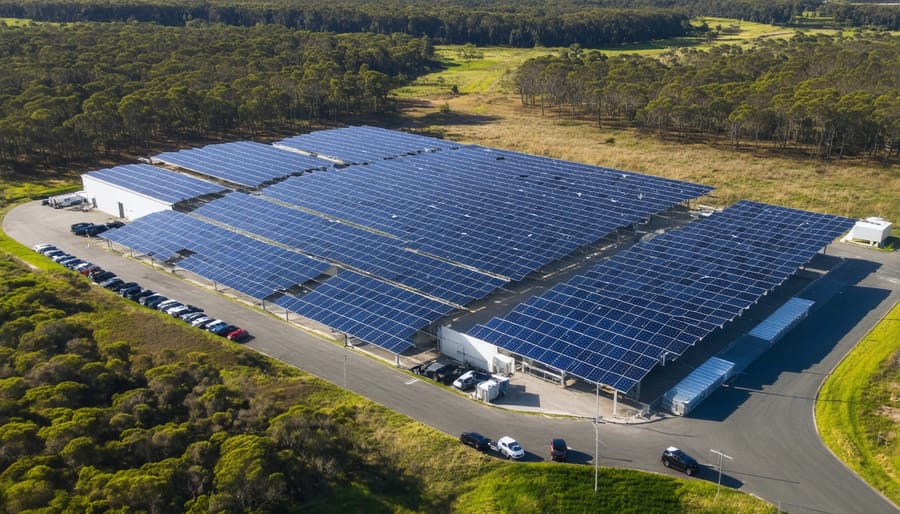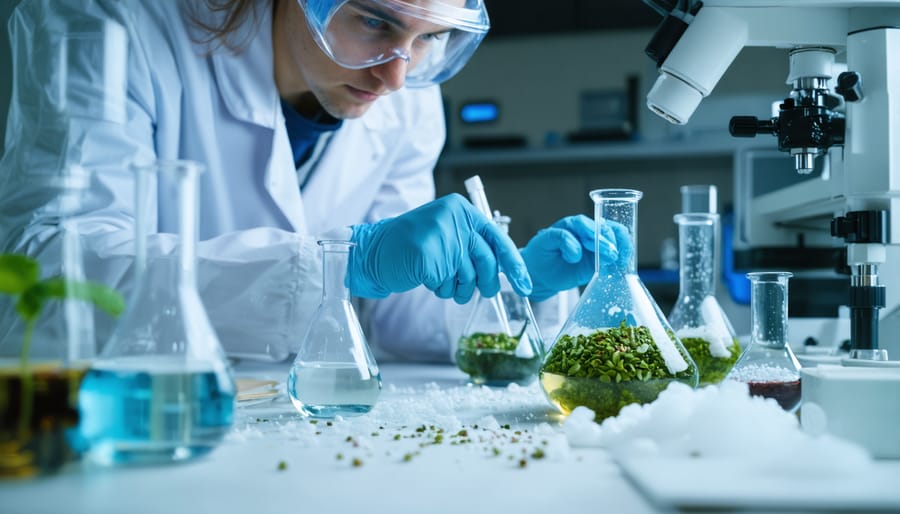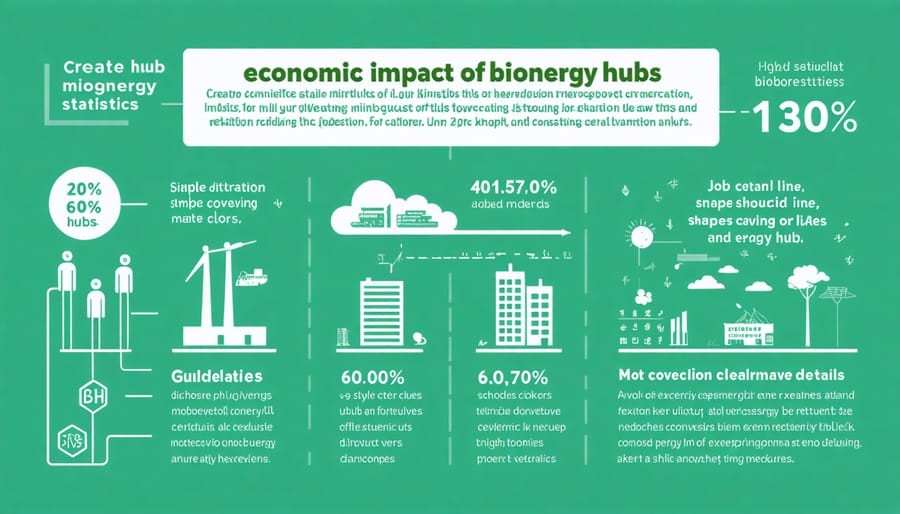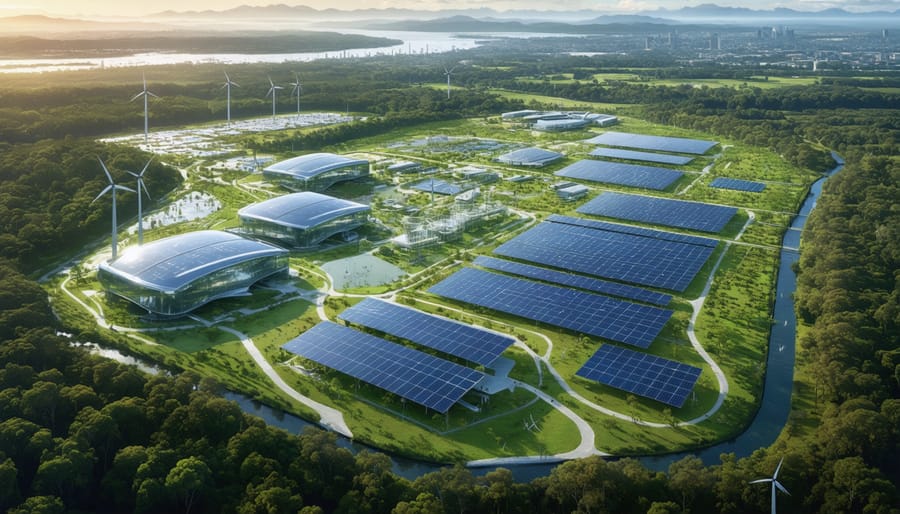At the heart of Australia’s renewable energy revolution, energy innovation hubs are transforming how we harness, store, and distribute sustainable power. These dynamic centers of excellence showcase the growing significance of bioenergy alongside other cutting-edge technologies, driving the nation towards a cleaner, more sustainable future.
From Newcastle’s world-class hydrogen facility to Queensland’s biorefinery precinct, these innovation hubs serve as living laboratories where researchers, industry leaders, and entrepreneurs collaborate to solve our most pressing energy challenges. They represent more than just research facilities; they’re catalysts for economic growth, creating thousands of jobs while developing solutions that can be scaled globally.
What sets Australian energy innovation hubs apart is their unique approach to integration – combining research capabilities, commercial expertise, and government support under one roof. This collaborative ecosystem accelerates the journey from concept to commercialization, ensuring breakthrough technologies can rapidly transition from laboratory success to real-world implementation.
By fostering partnerships between universities, industry, and government agencies, these hubs are pioneering the next generation of renewable energy solutions, positioning Australia as a global leader in clean energy innovation and sustainable technology development.
The Rise of Bioenergy Innovation Hubs in Australia
Key Players and Locations
Australia’s bioenergy landscape is dotted with several cutting-edge innovation hubs, each contributing uniquely to sustainable energy solutions. The Queensland Biofutures Precinct in Gladstone stands as a flagship facility, where researchers are pioneering advanced biofuel technologies using sugarcane waste and algae cultivation.
In New South Wales, the Newcastle Bioenergy Research Centre has become a powerhouse for waste-to-energy innovations, partnering with local councils to transform municipal waste into clean energy. The Western Australian Renewable Energy Hub in Perth specializes in agricultural waste conversion, working closely with farming communities to create circular energy systems.
Victoria’s Gippsland Region hosts the Bioenergy Innovation Cluster, where forestry residues are transformed into valuable energy products. Meanwhile, South Australia’s Adelaide Bioenergy Centre focuses on developing drought-resistant energy crops and innovative storage solutions.
These hubs form a nationwide network, connecting regional communities with urban centers and creating opportunities for sustainable development across the continent. Each facility serves as both a research center and a practical demonstration site, showing how bioenergy can power Australia’s future.

Collaborative Framework
Energy innovation hubs thrive on the power of collaboration, bringing together Australia’s brightest minds from diverse sectors. These dynamic spaces foster partnerships between leading research institutions like CSIRO and major universities, innovative industry players, and government bodies at both state and federal levels.
The collaborative framework typically operates through a hub-and-spoke model, where a central facility coordinates multiple satellite locations and partner organisations. Regular workshops, knowledge-sharing sessions, and joint research projects create an ecosystem of innovation where ideas flow freely between participants.
Industry partners contribute practical expertise and real-world testing opportunities, while research institutions provide cutting-edge scientific knowledge and experimental facilities. Government bodies offer policy guidance and funding support, ensuring projects align with national energy objectives.
This three-way partnership accelerates the development of new technologies by combining academic research with commercial viability testing and regulatory compliance. Success stories include the development of advanced biofuel processing methods and smart grid technologies, which emerged from collaborative efforts between university researchers, energy companies, and government agencies.
The framework also encourages international collaboration, connecting Australian innovation hubs with global partners to share expertise and accelerate progress toward renewable energy solutions.
Groundbreaking Projects and Technologies

Agricultural Waste to Energy
In the heart of Queensland’s sugarcane country, innovative farmers and energy specialists are revolutionizing how we think about agricultural waste conversion. The Mackay Bioenergy Hub stands as a shining example, transforming sugarcane bagasse into both electricity and biofuel, powering over 30,000 homes while creating new revenue streams for local farmers.
The success story continues in New South Wales, where the Northern Rivers Bioenergy Project has mastered the art of converting macadamia nut shells and other agricultural residues into clean energy. This innovative facility not only processes 20,000 tonnes of waste annually but also provides sustainable power to nearby food processing facilities, creating a circular economy model that’s caught the attention of industry leaders nationwide.
In Victoria’s Goulburn Valley, fruit processors have partnered with energy innovators to convert fruit pulp and organic waste into biogas. The facility generates enough power to run its operations and feeds excess energy back into the grid, demonstrating how food waste can become a valuable energy resource.
These projects showcase the incredible potential of agricultural waste-to-energy initiatives in Australia. By transforming what was once considered worthless into valuable energy resources, these hubs are creating new opportunities for farmers while contributing to our renewable energy targets. The technology is proving particularly valuable in regional areas, where agricultural waste is abundant and energy needs are significant.
What makes these initiatives truly remarkable is their ability to solve multiple challenges simultaneously: reducing waste, creating renewable energy, and supporting regional economies. As these success stories demonstrate, agricultural waste-to-energy projects are no longer just promising concepts but proven solutions delivering real benefits to Australian communities.
Next-Generation Biofuels
Australia’s biofuel landscape is undergoing a remarkable transformation with cutting-edge innovations that are reshaping our approach to sustainable energy. Leading research facilities across the country are pioneering next-generation biofuel technologies that promise to revolutionise our transport and industrial sectors.
One of the most exciting developments is the emergence of algae-based biofuels, with researchers in Queensland successfully cultivating high-yield strains that produce up to five times more oil than traditional crops. These microscopic powerhouses not only generate clean fuel but also absorb significant amounts of carbon dioxide during growth, creating a dual environmental benefit.
The innovation hub’s waste-to-fuel initiatives are equally impressive, converting agricultural residues and organic waste into advanced biofuels. In New South Wales, a groundbreaking facility is turning sugar cane bagasse into cellulosic ethanol, while simultaneously developing processes for converting urban green waste into renewable diesel.
What sets these next-generation biofuels apart is their minimal impact on food production and land use. Unlike first-generation biofuels that relied heavily on food crops, these innovative solutions utilize non-food biomass, industrial waste, and even carbon dioxide as feedstock. This approach has garnered support from farmers and environmental groups alike.
The hub’s collaborative approach has been crucial in overcoming technical challenges. By bringing together scientists, engineers, and industry partners, we’re seeing rapid advancement in enzyme technology and processing efficiency. These improvements have significantly reduced production costs, making biofuels increasingly competitive with conventional fuels.
Looking ahead, these innovations are set to play a vital role in Australia’s renewable energy mix, particularly in sectors where electrification poses challenges, such as aviation and heavy transport. The future of clean energy is here, and it’s growing in our own backyard.

Economic and Environmental Impact
Job Creation and Skills Development
The energy innovation hub is proving to be a powerful catalyst for job creation across Australia’s renewable energy sector. As the bioenergy industry expands, it’s generating diverse employment opportunities, from technical roles in engineering and biotechnology to positions in project management and sustainable agriculture.
The hub’s commitment to skills development is evident through its comprehensive training programs, which are bridging the gap between traditional energy sector skills and the emerging needs of the bioenergy industry. Local partnerships with TAFE institutions and universities are creating pathways for students and mid-career professionals to transition into renewable energy careers.
Success stories are emerging across the country, with regional communities particularly benefiting from these initiatives. In Queensland, former sugarcane farmers are now managing biomass processing facilities, while in Victoria, automotive workers have successfully transferred their skills to bioenergy plant operations.
The hub’s apprenticeship program has been particularly successful, with over 200 apprentices trained in the past year alone. These programs focus on practical skills like biomass handling, anaerobic digestion system maintenance, and sustainable waste management practices.
Looking ahead, industry projections suggest the bioenergy sector could create up to 10,000 new jobs by 2030, with many of these positions supporting regional development. The hub’s ongoing investment in workforce development ensures Australia remains at the forefront of renewable energy innovation while building a skilled workforce for the future.
Carbon Reduction Success Stories
The energy innovation hub has delivered remarkable results in carbon reduction across multiple sectors. In Western Sydney, our flagship waste-to-energy project has successfully diverted 50,000 tonnes of organic waste from landfills annually, reducing greenhouse gas emissions by an estimated 85,000 tonnes of CO2 equivalent. This achievement equals taking approximately 18,000 cars off the road for a year.
Another standout success comes from our partnership with a major agricultural cooperative in Victoria, where implementing biogas capture systems across dairy farms has slashed methane emissions by 70% while providing clean energy to power farm operations. The initiative has inspired neighbouring farms to adopt similar practices, creating a ripple effect of positive environmental change.
In Queensland, our industrial precinct project has helped five manufacturing facilities transition to renewable energy sources, resulting in a combined carbon reduction of 120,000 tonnes annually. This transformation not only benefits the environment but has generated significant cost savings for participating businesses.
Perhaps most encouraging is our collaboration with regional councils, where innovative waste management solutions have been implemented across 12 communities. These projects have achieved a 40% reduction in landfill emissions while creating local jobs and generating clean energy for community facilities. These success stories demonstrate that with the right technology and community engagement, significant environmental improvements are not just possible – they’re already happening.
Future Directions and Opportunities
Emerging Technologies
The future of bioenergy in Australia is brimming with groundbreaking innovations that promise to revolutionise our energy landscape. One of the most exciting developments is the emergence of advanced algae-based biofuels, which are being cultivated in high-tech photobioreactors across Queensland’s sunny coastline. These microscopic powerhouses can produce up to 60 times more oil per hectare than traditional crops while absorbing significant amounts of CO2.
Waste-to-energy technologies are also experiencing a remarkable evolution, with new thermal conversion processes that can handle multiple waste streams simultaneously. Australian researchers are pioneering hybrid systems that combine anaerobic digestion with pyrolysis, maximising energy recovery while minimising environmental impact.
Agricultural innovation is driving the development of designer energy crops, specifically engineered for Australian conditions. These plants are drought-resistant and capable of thriving in marginal lands, ensuring they don’t compete with food production. Meanwhile, breakthrough enzyme technologies are making biofuel production more efficient and cost-effective than ever before.
Perhaps most promising is the development of integrated biorefinery systems that can produce not just energy, but also high-value biochemicals and materials. These smart facilities use artificial intelligence to optimise production processes and adapt to changing feedstock conditions, representing the next generation of energy innovation hubs. With these technologies on the horizon, Australia is well-positioned to become a global leader in sustainable bioenergy production.
Investment and Growth Potential
The energy innovation hub sector in Australia presents compelling investment opportunities, with projections indicating a potential market value of $15 billion by 2030. As global demand for sustainable energy solutions continues to grow, these hubs are attracting significant attention from both domestic and international investors. The combination of Australia’s abundant renewable resources and established research infrastructure makes these hubs particularly attractive for long-term investment.
Several major renewable energy projects have already demonstrated impressive returns, with early-stage investors seeing average annual growth rates of 12-15%. The expansion potential is particularly promising in regional areas, where these hubs create sustainable jobs while driving technological innovation.
Investment opportunities span various sectors, from direct facility development to technology commercialization and supply chain optimization. The integration of artificial intelligence and smart grid technologies within these hubs opens up additional growth pathways, particularly in energy storage and distribution solutions.
For communities and businesses looking to participate in this growth, options range from direct investment in hub infrastructure to partnerships with research institutions and technology providers. The government’s commitment to reaching net-zero emissions has created a supportive policy environment, making now an ideal time to invest in Australia’s energy innovation future.
Bioenergy innovation hubs represent more than just research facilities or technological centres – they are catalysts for Australia’s sustainable future. These dynamic spaces are transforming how we think about and use energy, creating ripple effects that extend far beyond their physical boundaries. From turning agricultural waste into valuable fuel to developing cutting-edge biomass technologies, these hubs are proving that sustainable solutions can also be economically viable.
The success stories emerging from these innovation centres demonstrate that Australia is well-positioned to become a global leader in bioenergy. Whether it’s a regional hub turning sugarcane waste into bioethanol or an urban facility converting food waste into renewable gas, these achievements show what’s possible when innovation meets determination.
The time to get involved is now. Whether you’re a farmer with biomass resources, an investor looking for sustainable opportunities, or a community member passionate about renewable energy, there’s a role for you in this growing sector. Local councils, businesses, and individuals can all contribute to and benefit from these innovation hubs.
By supporting and engaging with bioenergy innovation hubs, we’re not just investing in technology – we’re investing in cleaner air, regional jobs, and a more sustainable future for all Australians. The pathway to renewable energy independence is being paved through these hubs, and together, we can turn this vision into reality. Let’s embrace this opportunity to shape a greener, more prosperous tomorrow.

